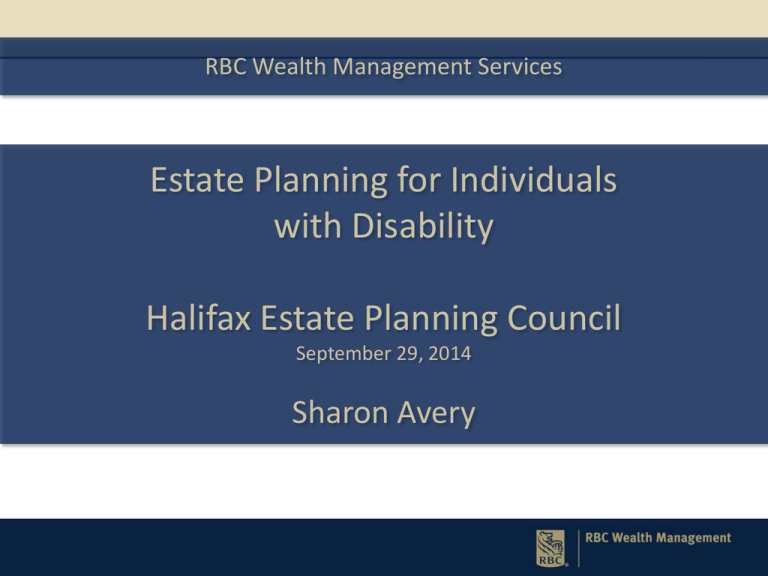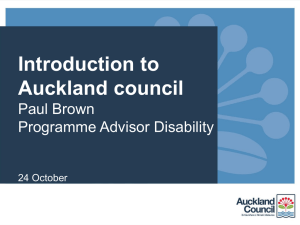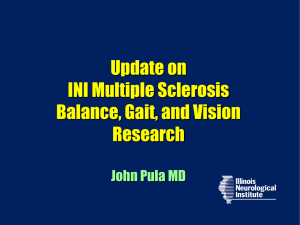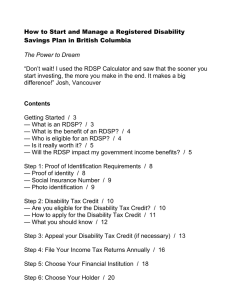
RBC Wealth Management Services
Estate Planning for Individuals
with Disability
Halifax Estate Planning Council
September 29, 2014
Sharon Avery
*http://disability.novascotia.ca/sites/default/files/StatisticalReport_2010.pdf
Disability Statistics*
In 2006, an estimated 4.4 million Canadians living in households reported
having a disability, an increase of over 3/4 of a million in five years.
In 2001, 12.4 percent of the Canadian population reported a disability, by
2006 this rate had increased to 14.3 percent.
Disability rate in Nova Scotia increased from 17.1 percent to 20 percent.
There were 179,100 individuals in the province who reported some form of
disability.
Provinces in the East had, on average, higher disability rates than those in
the West.
*http://disability.novascotia.ca/sites/default/files/StatisticalReport_2010.pdf
Financial & Estate Planning for Disabled Individuals
There is no universal definition of disability. Each government department or
agency (federal, provincial, territorial, and municipal) has its own definition,
based on applicable legislation and the purpose of a given program.
Caring for an individual with disability and planning for their financial support
can be a significant responsibility. There are financial and estate planning
options available:
•Disability Tax Credit
•Child Disability Benefit
•Henson Trusts
•RDSP
•Lifetime Benefits Trust
•Qualified Trust Annuity
Disability Tax Credit
The disability tax credit (DTC) is a non-refundable tax credit used to reduce
income tax payable on the income tax and benefit return. A person with a
severe and prolonged impairment in physical or mental functions may claim
the disability amount once they are eligible for the DTC.
The purpose of the DTC is to provide for greater tax equity by allowing some
relief for disability costs, since these are unavoidable additional expenses
that other taxpayers don’t have to face. Being eligible for the DTC can open
the door to other federal, provincial, or territorial programs such as the
registered disability savings plan, the working income tax benefit, and the
child disability benefit.
Disability Tax Credit
For income tax purposes, an individual is
considered disabled if they are eligible for
the Disability Tax Credit (DTC).
A physician must certify that the individual
suffers from a severe and prolonged
mental or physical impairment that
markedly restricts his or her basic activity
of daily living (almost) all of the time.
The impairment must have lasted (or is
reasonably expected to last) for at least 12
consecutive months – prolonged disability.
Maximum Disability Tax Credit Amount for
2013 is $7,697
The Disability Tax Credit and Promoters
The Disability Tax Credit Promoters Restrictions Act received Royal Assent on
May 29, 2014. The Act limits fees that can be charged for helping to
complete a disability tax credit request, and ensure that more money stays
in the pockets of persons with disabilities and their caregivers who need it
most.
The Canada Revenue Agency will hold public consultations in the coming
months. You can request to be informed when the consultations will be
scheduled.
http://www.parl.gc.ca/LEGISinfo/BillDetails.aspx?Mode=1&billId=5814389&Language=E
Child Disability Benefit
The Child Disability Benefit (CDB) is a tax-free benefit for families who care
for a child under age 18 who is eligible for the disability amount.
A child is eligible for the disability amount when a qualified practitioner
certifies, on Form T2201, Disability Tax Credit Certificate, that the child has a
severe and prolonged impairment in physical or mental functions, and the
Canada Revenue Agency (CRA) approves the form.
The Child Disability Benefit (CDB) is a tax-free benefit of up to $2,650 per
year ($220.83 per month) for families who care for a child under age 18 with
a severe and prolonged impairment in physical or mental functions.
Registered Disability Savings Plan
A registered disability savings plan (RDSP) is a savings plan
that is intended to help parents and others save for the
long term financial security of a person who is eligible for
the disability tax credit.
Incentives to save for disabled individuals
Canada Disability Savings Grant (based on family income
and matching or surpassing contributions up to certain
amounts – max grant is $70k)
Canada Disability Savings Bond
(grant for low income individuals
maximum is 20K)
RDSP
Contributions to an RDSP are not tax deductible and can be made until the
end of the year in which the beneficiary turns 59.
Contributions that are withdrawn are not included in income for the
beneficiary when they are paid out of an RDSP.
However,
•
•
•
•
the Canada disability savings grant,
the Canada disability savings bond,
investment income earned in the plan, and
rollover amounts
are included in the beneficiary's income for tax purposes when they are paid
out of the RDSP.
•
Who can become a beneficiary of an RDSP?
You can designate an individual as beneficiary of an RDSP if the individual:
•
•
•
•
is eligible for the disability tax credit (DTC);
has a valid social insurance number (SIN);
is a resident in Canada when the plan is entered into; and
is under the age of 60 (a plan can be opened for an individual until the end of
the year in which they turn 59). The age limit does not apply when a
beneficiary's RDSP is opened as a result of a transfer from the beneficiary's
former RDSP.
A beneficiary can only have one RDSP at any given time, although this RDSP
can have several plan holders throughout its existence, and it can have more
than one plan holder at any given time.
RDSP – Some important facts
So Only one RDSP per individual
Must qualify for DTC
the overall lifetime limit for a particular
beneficiary is $200,000 (all contributions
and rollover transfers that have
previously been made to any RDSP will
reduce this amount).
There is no annual limit on amounts that
can be contributed to an RDSP of a
particular beneficiary in a given year.
However, Contributions are permitted
until the end of the year in which the
beneficiary turns 59.
To open an RDSP, a person who qualifies to be a holder of the plan must
contact a participating financial institution that offers RDSPs.
These financial institutions are known as issuers.
.
Who can open an RDSP
Under 19 (age of majority)
– a parent of the beneficiary;
– a guardian, tutor, or curator of the beneficiary, or another legally authorized to act; or
– a public department, agency, or institution legally authorized to act for the beneficiary.
Over age of majority & legally able to enter into a contract
– RDSP can be established for such a beneficiary by the beneficiary.
– If a legal parent is, at the time the plan is established, a holder of a pre–existing RDSP for the
adult beneficiary, the legal parent may become the sole holder of the plan or a joint holder
of the plan with the beneficiary.
Over the age of majority but legal ability to enter into a contract in doubt
– a "qualifying family member" may open a plan under
– Only June 29, 2012 to December 31, 2016.
– These rules will not apply if an RDSP has already been opened
– A "qualifying family member" if after reasonable inquiry, it is the opinion of a financial
institution that offers RDSPs (RDSP issuer), that an adult individual’s ability to enter into a
contract is in doubt.
– A "qualifying family member" includes a spouse, common-law partner, or parent of an
individual
Two types of withdrawals: flexible payments (payments which can be
requested anytime for example a wheelchair) or lifetime disability
assistance (payments which are regularly scheduled payments based on a
formula – begin at age 60)
Deceased may rollover RRSP or RRIF to financially dependent infirm child or
grandchild to maximum contribution level on a tax deferred basis.
This option is discussed more later…..
Henson Trust
Is an absolute discretionary trust
Only amounts vesting are payments made to
disabled person
No right to income of capital in trust by disabled
person
Protects provincial benefits in provinces that allow
such trust
Trustees may withhold income and assets from
disabled beneficiary
May be testamentary or inter vivos
Not all provinces recognize Henson Trusts (such as
Alberta) – some only allow with maximum amounts
being held in the trust (such as New Brunswick)
Does not require that the disabled person qualifies
for DTC
No maximum contribution limit
Residual beneficiaries can be named
RRSP or RRIF Rollovers
Ordinary rules say tax on death for full market
value
Some limited exceptions (rollover or deferrals)
– Spouse
– Financially dependent child or grandchild
• If healthy children
– Roll to annuity fixed until 18 years of age
• If disabled physically or mentally
– Could rollover to RRSP or fixed term annuity
– But a problem – if mentally disabled problems
establishing or administering the RRSP or
annuity where the prime beneficiary (the
disabled person) lacked capacity to direct the
RRSP
Transferring RRSP/RRIF on a rollover to an RDSP
The maximum rollover amount into an RDSP is $200,000. All contributions and
rollover amounts made to any RDSP will reduce this amount. Grants will not be paid
into the RDSP on the money you rollover.
Since July 1, 2011 , for deaths occurring after March 3, 2010, the RDSP rules allow
for a rollover of a deceased individual's registered retirement savings plan (RRSP)
proceeds to the registered disability savings plan (RDSP) of the deceased
individual's financially dependent child or grandchild with an impairment in
physical or mental functions. A qualifying beneficiary is referred to as an eligible
individual. These rollover rules also apply to registered retirement income
fund(RRIF) proceeds, to certain lump-sum amounts paid from registered pension
plans (RPPs), to the specified pension plans (SPP), or to pooled registered pension
plans (PRPPs).
As of June 28, 2012, upon the death of an annuitant of a pooled registered pension
plan (PRPP), the amounts from a PRPP can be transferred into an RDSP of an infirm
dependent child/grandchild or an infirm dependent child/grandchild who has
attained the age of majority but is not considered contractually competent to enter
into a disability savings plan. The amount of the transfer is not reported as income
nor deducted by either the annuitant or the beneficiary.
RRSP or RRIF Rollovers for Mentally Disabled Dependent
Financially dependent child or grandchild
• If Mentally disabled and unable to administer RRSP on rollover
– 60.011 ITA
– Lifetime Benefit Trust (effective June 2013 retroactive to 1989)
» Personal trust where mentally disabled spouse or dependent child or
grandchild is the sole beneficiary of any income or capital of the trust.
» Trustees may pay income or capital to the beneficiary but are not required to
pay out all the income of the LBT to the beneficiary
» Trustees are required to consider the needs of the beneficiary including
comfort, care and maintenance.
RRSP or RRIF Rollovers for Mentally Disabled Dependent
Financially dependent children
– Qualifying Trust Annuity – must be purchased by the
LBT with the RRSP/RRIF proceeds coming from the
deceased parent or spouse (to benefit the disabled
spouse or child)
– Must be for the life of the taxpayer (disabled person)
with or without a guaranteed person or for a fixed
term equal to 90 years minus the age of the taxpayer
– If death occurs during the fixed term or guaranteed
period amounts otherwise payable after the death of
the taxpayer must be commuted to a single payment.
– Any amounts paid out of QTA to the beneficiary of
the LBT will be fully taxed to the beneficiary
56(1)(d.2) and 75.2
RRSP or RRIF Rollovers
Financially dependent children
– Tax at death of beneficiary is at FMV of
annuity at time of death and is fully taxable to
the beneficiary in the year of his or her death.
– Any amount remaining of the QTA after death
of beneficiary (and taxes paid) is available to
other beneficiaries named in LBT
– In regular RRSP rollover to physically or
mentally disabled person potential that no
ability to bequeath the remaining proceeds on
death of the disabled person if individual does
not have capacity to give Will instructions
(thus resulting in devolution based on
intestate succession rules).
Example
My son Ricky…
• Has Spina Bifida & Hydrocephalus
• Physically and mentally disabled
• Mentally capable in certain areas
• Neuropsychology test says his
developmental age is 8 in some areas
• Not able to manage money
• Could be victimized
• Works fulltime as a Walmart greeter
• Diehard country music fan
• Is absolutely magnificent
Example
My son Ricky…
• Qualifies for DTC
• Plan calls for RDSP, Henson & LBT
• Rollover as much as possible to RDSP –
why? May look at more than “comfort,
care and maintenance” also perhaps
education, travel, housing (may
collapse if his health changes)
• Still possible to rollover RRSPs to an
RRSP for Ricky (previous LBT option)
and Ricky MAY be able to give
directions to administer the RRSP fund
in his name but maybe not….so….
• Rollover to LBT and QTA
The strategies, advice and technical content in this presentation are provided for the general guidance and benefit of the presentation
participants, based on information that we believe to be accurate, but we cannot guarantee its accuracy or completeness. This presentation is
not intended as nor does it constitute legal or tax advice. Participants should consult their own lawyer, accountant or other professional
advisor when planning to implement a strategy. This will ensure that the particular client circumstances have been considered properly and
that action is taken on the latest available information.
This presentation has been prepared for use by Royal Bank of Canada, RBC Dominion Securities*, RBC Phillips, Hager & North Investment
Counsel Inc. and RBC Global Asset Management Inc. Royal Bank of Canada, RBC Phillips, Hager & North Investment Counsel Inc., RBC
Global Asset Management Inc., Royal Mutual Funds Inc., and RBC Dominion Securities Inc. are separate corporate entities that are affiliated.
RBC Phillips, Hager & North Investment Counsel Inc., RBC Global Asset Management Inc., RBC Dominion Securities Inc., and the Private
Banking division of Royal Bank of Canada are member companies under RBC Wealth Management. *Member – Canadian Investor Protection
Fund. ®Registered trademark of Royal Bank of Canada. RBC Wealth Management is a registered trademark of Royal Bank of Canada, a
business segment of Royal Bank of Canada. Used under licence. ©2014 Royal Bank of Canada. All rights reserved.












